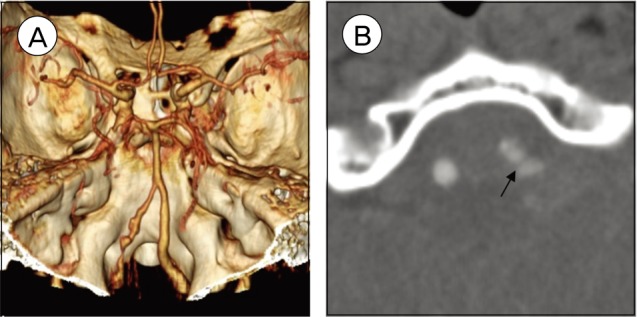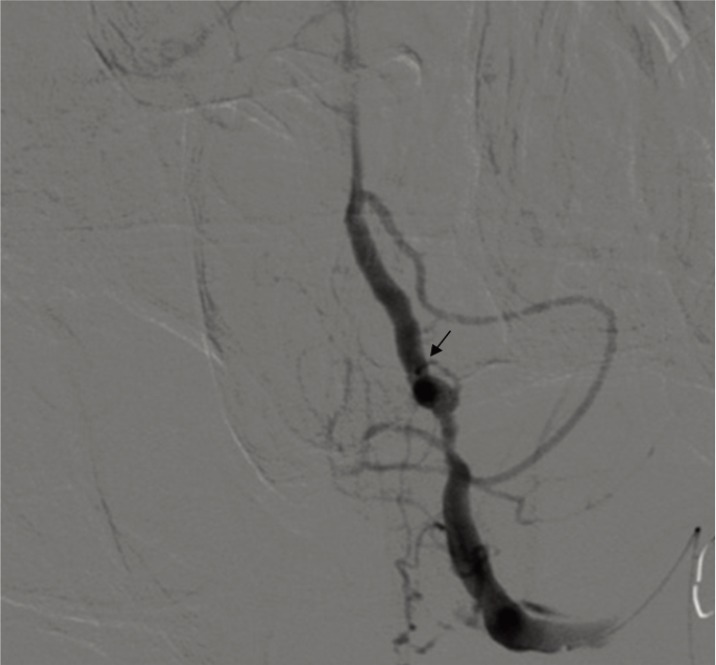J Cerebrovasc Endovasc Neurosurg.
2013 Jun;15(2):96-101. 10.7461/jcen.2013.15.2.96.
Endovascular Coil Trapping of a Ruptured Dissecting Aneurysm of the Vertebral Artery Using Detachable Coils and Micro-Tornado(R) Coils
- Affiliations
-
- 1Department of Neurosurgery, Dong Kang Medical Center, Ulsan, Republic of Korea. 1004@jbnu.ac.kr
- KMID: 1980435
- DOI: http://doi.org/10.7461/jcen.2013.15.2.96
Abstract
- We experienced a patient with a ruptured dissecting aneurysm of the vertebral artery who was treated by trapping of the lesion using Guglielmi detachable coils (GDCs) with micro-tornado(R) coils (MTCs). An 80-year-old male was transferred with a ruptured left vertebral artery dissecting aneurysm (VADA). The dissected portion of the vertebral artery was effectively trapped using GDCs and MTCs. The MTCs used for neurointervention were comprised of various types of coils and we successfully placed them into the parent artery of the dissected segment. The author suggests that this case demonstrates the usefulness of endovascular coil trapping of VADAs using MTCs in achievement of embolization.
Keyword
MeSH Terms
Figure
Reference
-
1. Aoki N, Sakai T. Rebleeding from intracranial dissecting aneurysm in the vertebral artery. Stroke. 1990; 11. 21(11):1628–1631. PMID: 2237959.
Article2. Byrne JV, Beltechi R, Yarnold JA, Birks J, Kamran M. Early experience in the treatment of intra-cranial aneurysms by endovascular flow diversion: a multicentre prospective study. PLoS One. 2010; 9. 5(9):e12492. PMID: 20824070.
Article3. Guglielmi G, Vinuela F, Sepetka I, Macellari V. Electrothrombosis of saccular aneurysms via endovascular approach. Part 1: Electrochemical basis, technique and experimental results. J Neurosurg. 1991; 7. 75(1):1–7. PMID: 2045891.4. Hayashi K, Kitaqawa N, Morikawa M, Hiu T, Morofuji Y, Suyama K, et al. MicroNester coil for neurointervention. J Neurosurg. 2009; 1. 110(1):40–43. PMID: 18821834.
Article5. Ihn YK, Sung JH, Byun JH. Antegrade recanalization of parent artery after internal trapping of ruptured vertebral artery dissecting aneurysm. J Korean Neurosurg Soc. 2012; 5. 51(5):301–304. PMID: 22792429.
Article6. Iihara K, Sakai N, Murao K, Sakai H, Higashi T, Kogure S, et al. Dissecting aneurysms of the vertebral artery : a management strategy. J Neurosurg. 2002; 8. 97(2):259–267. PMID: 12186451.7. Jansen O, Dorfler A, Forsting M, Hartmann M, von Kummer R, Tronnier V, et al. Endovascular therapy of arteriovenous fistulae with electrolytically detachable coils. Neuroradiology. 1999; 12. 41(12):951–957. PMID: 10639676.
Article8. Jin SC, Kwon DH, Choi CG, Ahn JS, Kwun BD. Endovascular strategies for vertebrobasilar dissecting aneurysms. AJNR Am J Neuroradiol. 2009; 9. 30(8):1518–1523. PMID: 19474118.
Article9. Kai Y, Hamada JI, Morioka M, Todaka T, Mizuno T, Ushio Y. Endovascular coil trapping for ruptured vertebral artery dissecting aneurysms by using double microcatheters technique in the acute stage. Acta Neurochir (Wien). 003; 6. 145(6):447–451. discussion 451. PMID: 12836068.
Article10. Kim BM, Shin YS, Kim SH, Suh SH, Ihn YK, Kim DI, et al. Incidence and risk factors of recurrence after endovascular treatment of intracranial vertebrobasilar dissecting aneurysms. Stroke. 2011; 9. 42(9):2425–2430. PMID: 21778439.
Article11. Lemole GM Jr, Henn J, Javedan S, Deshmukh V, Spetzler RF. Cerebral revascularization performed using posterior inferior cerebellar artery-posterior inferior cerebellar artery bypass. Report of four cases and literature review. J Neurosurg. 2002; 7. 97(1):219–223. PMID: 12134919.12. Lylyk P, Cohen JE, Ceratto R, Ferrario A, Miranda C. Combined endovascular treatment of dissecting vertebral artery aneurysms by using stents and coils. J Neurosurg. 2001; 3. 94(3):427–432. PMID: 11235947.
Article13. MacKay CI, Han PP, Albuquerque FC, McDougall CG. Recurrence of a vertebral artery dissecting pseudoaneurysm after successful stent-supported coil embolization: case report. Neurosurgery. 2003; 9. 53(3):754–759. discussion 760-1. PMID: 12943592.
Article14. Mizutani T, Aruga T, Kirino T, Miki Y, Saito I, Tsuchida T. Recurrent subarachnoid hemorrhage from untreated ruptured vertebrobasilar dissecting aneurysms. Neurosurgery. 1995; 5. 36(5):905–911. discussion 912-3. PMID: 7791980.
Article15. Rabinov JD, Hellinger FR, Morris PP, Ogilvy CS, Putman CM. Endovascular management of vertebrobasilar dissecting aneurysms. AJNR Am J Neuroradiol. 2003; 8. 24(7):1421–1428. PMID: 12917140.16. Sugiu K, Tokunaga K, Watanabe K, Sasahara W, Ono S, Tamiya T, et al. Emergent endovascular treatment of ruptured vertebral artery dissecting aneurysms. Neuroradiology. 2005; 2. 47(2):158–164. PMID: 15703929.
Article17. Tsai CW, Lin TH, Ko CT, Chen MF, Lee YT. Transcatheter embolization of a coronary arteriovenous fistula with a complex, helical-fibered platinum coil. J Formos Med Assoc. 1996; 7. 95(7):558–561. PMID: 8840760.
- Full Text Links
- Actions
-
Cited
- CITED
-
- Close
- Share
- Similar articles
-
- Antegrade Recanalization of Parent Artery after Internal Trapping of Ruptured Vertebral Artery Dissecting Aneurysm
- Internal Trapping Using Detachable Coils for Ruptured Vertebral Artery-dissecting Aneurysms: Case Report
- Stent Assisted Coil Embolization of a Dissecting Aneurysm of the Vertebral Artery: A Case Involving a Patient with Hypoplasia of the Contralateral Vertebral Artery
- Endovascular Treatment of Intracranial Vertebral Artery Dissecting Aneurysms: Follow up Angiographic and Clinical Results of Endovascular Treatment in Serial Cases
- Emergent Endovascular Treatment of Ruptured Dissecting Aneurysm of the Intradural Vertebral Artery Using a Self-Expandable Intracranial Stent and a Bioactive Hydrophilic coil







